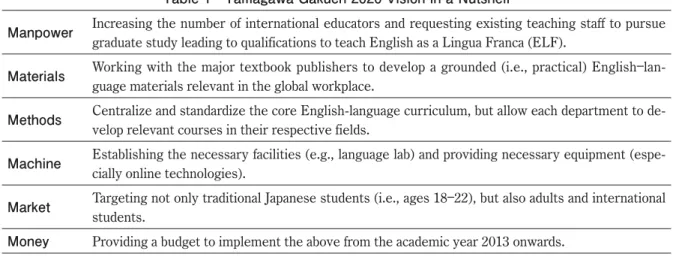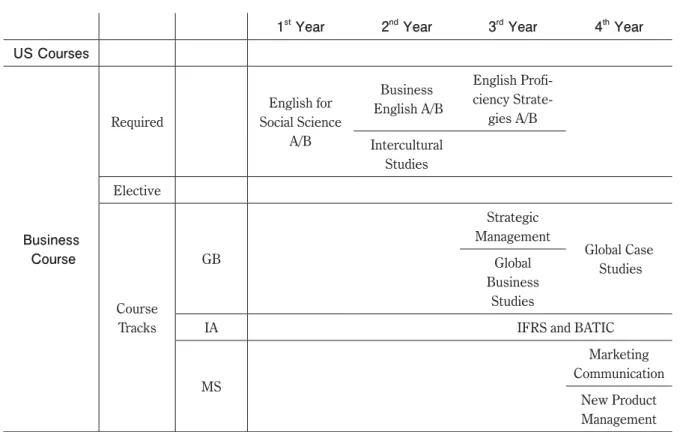[研究ノート]
Developing a Dual Language Program in the College of
Business Administration at Tamagawa University:
The Role of the CEFR for Languages
Dennis S. TACHIKI
Abstract
Tamagawa Gakuen has adopted a “2020 Vision” to globalize the delivery of education from primary school to graduate school (Tamagawa Gakuen 2012). In this connection, this article discusses the Depart-ment of International ManageDepart-ment’s efforts to impleDepart-ment a Dual Language Program integrating English and business courses throughout its four year curriculum. Using a Common European Framework of Ref-erence (CEFR) approach, (1) a scale, (2) Can Do Statement learning objectives, (3) on-line course materi-als and (4) proficiency tests are integrated into a GSE (Global Scale of English) eco-system. This should produce students who are not only proficient in English, but also can function in an Englishlanguage work environment.
Keywords: Common European Framework of Reference (CEFR), Global Scale of English (GSE) eco-system, Can Do Statements, Dual Language Program
Tamagawa Gakuen has adopted a “2020 Vision” to globalize the delivery of education from primary school to graduate school (Tamagawa Gakuen 2012). Table 1 highlights some of the key resources identi-fied to further globalize education at Tamagawa Gakuen.
Table 1 Tamagawa Gakuen 2020 Vision in a Nutshell
Manpower Increasing the number of international educators and requesting existing teaching staff to pursue graduate study leading to qualifications to teach English as a Lingua Franca (ELF). Materials Working with the major textbook publishers to develop a grounded (i.e., practical)
English―lan-guage materials relevant in the global workplace.
Methods Centralize and standardize the core English-language curriculum, but allow each department to
de-velop relevant courses in their respective fields.
Machine Establishing the necessary facilities (e.g., language lab) and providing necessary equipment
(espe-cially online technologies).
Market Targeting not only traditional Japanese students (i.e., ages 18―22), but also adults and international
students.
Money Providing a budget to implement the above from the academic year 2013 onwards.
Under this vision, the Department of International Management in the College of Business Administra-tion has established a Dual Language Program (DLP). This paper explains the evolving role of the Com-mon European Framework of Reference (CEFR) for Language in Tamagawa University’s Department of International Management’s DLP.
Ⅰ.DUAL LANGUAGE PROGRAM
The main purpose of the DLP is to produce business leaders for a global economy through integrating English into the undergraduate curriculum along three course tracks: (1) Global Business, (2) International Accounting, and (3) Marketing Strategy (see学部紹介 for more information http://www.tamagawa.ac.jp/busi-ness_administration/about/index.html)..
Table 2 highlights the DLP courses within the overall Department of International Management curricu-lum (other courses not shown).
Table 2 Department of International Management DLP Curriculum 1st Year 2nd Year 3rd Year 4th Year US Courses Business Course Required English for Social Science A/B Business English A/B English Profi-ciency Strate-gies A/B Intercultural Studies Elective Course Tracks GB Strategic Management Global Case Studies Global Business Studies
IA IFRS and BATIC
MS
Marketing Communication
New Product Management
NOTE: US = University Standard (Liberal Arts) course; GB = Global Business Course; IA = International Accounting
Course; MS = Marketing Strategy Course
In the first two years, the curriculum focuses on developing the students’ academic skills in (1) read-ing, writread-ing, listening and speaking and (2) critical thinking. Table 3 illustrates some of the main learning points:
Table 3 Main Learning Points
Reading Writing Listening Speaking ESS • Vocabulary • Scanning newspapers and magazines • topic sentence • supporting sentences • concluding sentence
• Getting the gist and dictation
• Pronunciation • Small talk
BE • Case study• Data analysis • Summary paragraph• Expository writing • Understanding• Evaluation • Presentation• Discussion IS Application of four language skills to cross cultural understanding and communication
NOTE: ESS = English for Social Science; BE = Business English; IS = Intercultural Studies
And in the last two years, the focus shifts to (1) understanding business principles and (2) engaging in business practices. In this connection the DLP courses become more specific to a particular business func-tion. The Global Business Course emphasizes strategic management and simulations. The International Accounting Course on materials related to the International Financial Reporting Standards (IFRS) and Bookkeeping and Accounting Test for International Communication (BATIC). And the Marketing Strategy Course on marketing communication and new product management. By the end of their undergraduate study, all students should achieve a TOEIC (Test of English for International Communication) English profi-ciency score above 605 and/or obtain a qualification certificate in a business function.
Ⅱ.COMMON EUROPEAN FRAMEWORK OF REFERECE for LANGUAGES
Companies usually set a TOEIC standard of 605 or more to assess the English proficiency of job appli-cants. Table 4 shows the equivalent score across similar English proficiency tests.
Although TOEIC has added the writing and speaking component to its test, most students only take the listening and reading proficiency part. Moreover, companies often find students with high TOEIC scores ae unable to function in an English speaking workplace. Consequently, in the DLP we are adopting the
Com-Table 4 English Proficiency Test Equivalent Scores
TOEIC TOEFL Paper TOEFL CBT TOEFL IBT IELTS CEFR
0―250 0―310 0―30 0―8 0―10 A1 310―343 33―60 9―18 1.0―1.5 A1 255―400 347―393 63―90 19―29 2.0―2.5 A2 397―433 93―120 30―40 3.0 B1 3.5 B1 405―600 437―473 123―150 41―52 4.0 B1 477―510 153―180 53―64 4.5 B2 605―780 513―547 183―210 65―78 5.5―6.0 B2 550―587 213―240 79―95 6.5―7.0 C1 785―990 590―677 243―300 96―120 7.5―9.0 C2 Top Score 990 Top Score 677 Top Score 300 Top Score 120 Top Score 9 Top Level C2
mon European Framework of Reference (CEFR) for Languages as a measure of English proficiency because it allows us to pin-point what language skill students are encountering difficulties.
The CEFR is a framework created by the Council of Europe in 2001 as a baseline to compare the ap-proaches of the various English proficiency tests. An advantage of the CEFR is its Descriptive Scheme (2001). In particular, the “illustrative descriptors” are given in the form of “Can Do Statements” for each of the four language skills from Beginner Level (A1) to Advanced level (C2).. Table 5 shows some examples of the Can Do Statements (ALTE 2002).
These Can Do Statements are not only a qualitative measure of a student’s English proficiency, but also teachers can use them as “learning objectives” in their course syllabus. Rather than stating the topic for the class session (e.g., understand the reading), the Can Do Statement requires the students to perform a specific task (e.g., can read basic notices, instructions or information).
This approach is particularly effective with students at the lower level of English proficiency. Many of
Table 5 CEFR Can Do Statements
Listening/Speaking Reading Writing A1
Novice
Can understand basic instruc-tions or take part in a basic factual conversation on a pre-dictable topic.
Can understand basic notices, instructions or information.
Can complete basic forms, and write notes including times, dates and places.
A2
Can express simple opinions or requirements in a familiar context.
Can understand straightfor-ward information within a known area, such as on prod-ucts and signs and simple text-books or reports on familiar matters.
Can complete forms and write short simple letters or post-cards related to personal infor-mation.
B1 Inter-mediate
Can express opinions on ab-stract/cultural matters in a limited way or offer advice within a known area, and un-derstand instructions or public announcements.
Can understand routine infor-mation and articles, and the general meaning of non-routine information within a familiar area.
Can write letters or make notes on familiar or predictable matters.
B2
Can follow or give a talk on a familiar topic or keep up a con-versation on a fairly wide range of topics.
Can scan texts for relevant information, and understand detailed instructions or advice.
Can make notes while some-one is talking or write a letter including non-standard re-quests.
C1 Advanced
Can contribute effectively to meetings and seminars within own area of work or keep up a casual conversation with a good degree of fluency, coping with abstract expressions.
Can read quickly enough to cope with an academic course, to read the media for informa-tion or to understand non-standard correspondence.
Can prepare/draft professional correspondence, take reason-ably accurate notes in meetings or write an essay which shows an ability to communicate.
C2
Can advise on or talk about complex or sensitive issues, understanding colloquial refer-ences and dealing confidently with hostile questions.
Can understand documents, correspondence and reports, including the finer points of complex texts.
Can write letters on any sub-ject and full notes of meetings or seminars with good expres-sion and accuracy.
these students score very low on the TOEIC ( < 250) and become discouraged to learn English. But with the CEFR approach, students are clear what they have to do and when they “Can Do,” they feel a sense of accomplishment. Although their TOEIC score many not increase, at least they are making small steps in that direction. Indeed, we have found in surveys of students, those who preserve over time (i.e., study outside the classroom at least 2 hours per week during the semester) to make these small steps are the ones motivated to challenge a different language skill (i.e., reading, writing, listening, speaking) within a level (i.e., A1 ∼ C2) eventually try to move up a level. It is at this point that we notice an improvement in the TOEIC score.
Ⅲ.CEFR in EUROPE
We investigated the status of CEFR in England and found that this framework applies to English lan-guage training in general but there are few “Can Do Statements” that apply directly to business courses. In this regard we found the Pearson’s GSE (Global Scale of English) ecosystem an interesting approach. The GSE ecosystem consists of (1) scale targeting different audiences, of which Business English is one, (2) learning objectives in the form of Can Do Statements, (3) on-line and hardcopy course materials, and (4) tests.
From the Spring 2017 semester, we plan to align our ESS and BE course syllabus with the GSE. Un-fortunately the English proficiency level of around one-third of our students is at the A1 or A2 CEFR level. This means we must do some remedial work with these students. Fortunately, the GSE further breaks down the A1 and A2 levels into a more “granular, real-world measure of English language proficiency across the four skills” so that we address this issue. Since these Can Do Statements specifically apply to business situations, it fits our DLP approach to integrate English with business content.
These days students are using there smart phones during classroom exercise. The GSE ecosystem includes a number of on-line resources to supplement classroom activities. This gives the teacher the flexibility to teach students according to their English proficiency rather than in lock-step fashion (i.e., ev-eryone learns the same thing whether the materials is below their level or above their level). The on-line MyEnglishLab, for example, provides resources on the same topic but tailors the level of the exercise to the student’s CEFR level.
We will also use the Progress test to measure the English proficiency of students. One of the advan-tages of the Progress test is the inclusion of a speaking component. This is the one language skill Japanese students do not have so many opportunities to practice and score low on language proficiency tests. Conse-quently we would like to skew the class time towards speaking exercises. Since the Progress test is aligned with other scal3es such as the TOEIC we are hoping our students start to achieve a score of 605 and above in the future. To be continued...
REFERENCES
Association of Language Teachers in Europe (ALTE). 2002 ALTE Can Do Project . ALTE
Council of Europe. 2001 Common European Framework of Reference for Language Learning, Teaching, Assessment . Council of Europe
[研究ノート]


